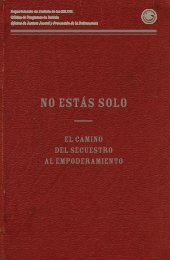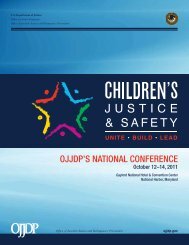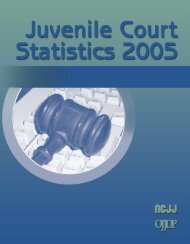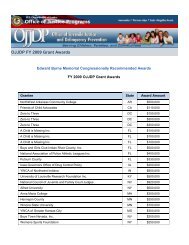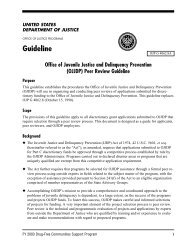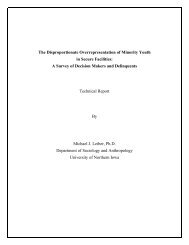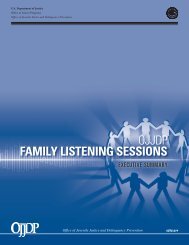Promising Strategies To Reduce Gun Violence - Office of Juvenile ...
Promising Strategies To Reduce Gun Violence - Office of Juvenile ...
Promising Strategies To Reduce Gun Violence - Office of Juvenile ...
Create successful ePaper yourself
Turn your PDF publications into a flip-book with our unique Google optimized e-Paper software.
◆ Are there unintended negative consequences <strong>of</strong><br />
the selected programs or strategies<br />
◆ What adjustments need to be made<br />
Communities should anticipate problems (barriers,<br />
unintended consequences, unforeseen changes, need<br />
for adjustments) and view them as opportunities for<br />
collaborative resolution.<br />
Evaluate the plan<br />
Evaluation is a critical component <strong>of</strong> a comprehensive<br />
gun violence reduction plan. It serves several<br />
purposes:<br />
◆ Increases the effectiveness <strong>of</strong> management and<br />
administration <strong>of</strong> the plan.<br />
◆ Documents that objectives have or have not been<br />
met.<br />
◆ Determines the overall efficacy <strong>of</strong> the plan and its<br />
component programs and strategies.<br />
Conducting an evaluation or a series <strong>of</strong> evaluations<br />
helps to ensure accountability, establishes whether<br />
the plan is making a difference, and provides important<br />
feedback for improving the plan.<br />
Revise the plan on the basis <strong>of</strong><br />
the evaluation<br />
A well-designed evaluation yields vital information.<br />
Evaluation results may suggest that changes should<br />
be made in the selection or implementation <strong>of</strong> programs<br />
and strategies, that additional training is<br />
warranted, or that other stakeholders need to be<br />
involved. Recommendations for improvement may<br />
come from the original partnership <strong>of</strong> stakeholders<br />
or from individual stakeholder groups. Assessments<br />
by the stakeholder partnership and by individual<br />
stakeholders will reveal which activities were most<br />
and least effective, which materials worked best and<br />
worst, and how barriers were overcome or proved<br />
insurmountable. If a community administers a comprehensive<br />
gun violence reduction plan for a substantial<br />
period <strong>of</strong> time with little or no progress<br />
toward identified objectives, an entirely new plan<br />
may need to be implemented.<br />
The U.S. Department <strong>of</strong> Justice’s Anti-Violent<br />
Crime Initiative (AVCI)—introduced in 1994—<br />
serves as one valuable model <strong>of</strong> the strategic<br />
planning process. <strong>To</strong> implement the AVCI, every<br />
U.S. Attorney met with all pertinent Federal,<br />
State, and local law enforcement agencies and<br />
formed a new, or newly strengthened, violent<br />
crime working group. These working groups<br />
identified and prioritized the critical violent<br />
crime problems that are susceptible to a<br />
coordinated Federal/State/local approach.<br />
They also developed short- and long-range<br />
objectives and implemented programs and<br />
strategies to address the relevant local crime<br />
problems. More information is available from<br />
your local U.S. Attorney’s <strong>of</strong>fice.<br />
Section II: Solving the Problem <strong>of</strong> <strong>Gun</strong> <strong>Violence</strong> 13



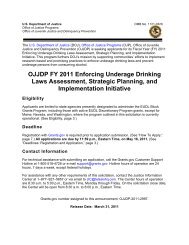
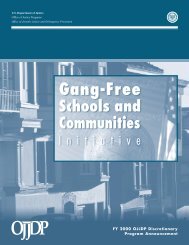
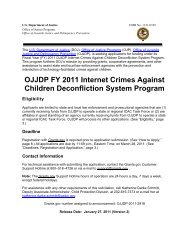
![Chapter 5 [PDF] - Office of Juvenile Justice and Delinquency ...](https://img.yumpu.com/46584340/1/190x245/chapter-5-pdf-office-of-juvenile-justice-and-delinquency-.jpg?quality=85)


